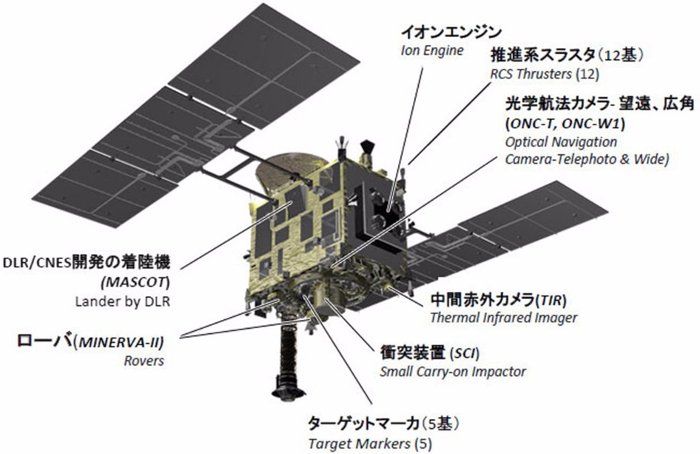The Hayabusa 2 probe is on its way to reach the JU3 Ryugu meteorite
The Japan Space Exploration Agency (JAXA) has just confirmed that the probe Hayabusa 2 is on its way to approach meteorite 1999 JU3 (Ryugu) after successfully executing a rubber shot (slingshot) - a trick Fly a lot around the Earth to harness gravity, get acceleration big enough to follow a planet. The roundabout was carried out by Hayabusa 2 since December 3 with the closest approach 3090km from Earth, above the Hawaiian Islands.
Hayabusa 2 was launched on December 3, 2014 from the Tanegashima space center with a mission that not only approached, landed successfully on a celestial body but also . set a bomb to destroy it . The probe is equipped with an ion push system and it has spent almost a year on an orbit chasing the Earth. So when the train catches up to Earth, the gravity from the planet changes the trajectory of the ship at an angle of 80 degrees and accelerates the train from 1.6km / s to 31.9km / s. This allows the ship to approach the meteorite 1999 JU3 Ryugu - a C- type meteorite , expected to be accessible in July 2018.

Earth.
When Hayabusa 2 flies across Earth, it is tracked by JAXA as well as NASA's deep space network and NASA's space observatory. The condition of the ship was confirmed to be completely normal and is currently 4.15 million kilometers from Earth. During the acceleration, the ONC-T optical orientation camera on Hayabusa 2 has "enlisted" a lot of images of our planet.
Once Hayabusa 2 successfully approached the meteorite, it would conduct JU3 research with a series of carry-on equipment as well as use a specimen hook to collect matter from the surface and inside of the celestial body. jelly. Later, the ship will be converted into a re-entry vehicle, returning to Earth's atmosphere and returning home after completing 18 months of JU3 exploration.

Hayabusa 2 was launched on December 3, 2014 from Tanegashima space center.
In addition, Hayabusa 2 carried a squadron of small amphibious vehicles to study the meteorite surface. They include two Minerva II self-propelled cars designed to be able to slowly jump along the surface of this 900m-long meteorite with very small gravity and MASCOT landing vehicles.
However, the most spectacular experiment of this mission is Small-Carry on Impactor (SCI) - a type of bazooka warhead used in space. SCI consists of an explosive head placed on a copper cone weighing 2kg. When the SCI is fired at the surface, the detonator will be detonated and the molten copper shell forms a hole in the celestial body, revealing the submerged material that is protected from sunlight and the explosion will be enjoy the radiation activity of celestial bodies for billions of years.
- Japanese probe brings precious specimens back to Earth
- Japan successfully launched meteorite probes
- Japanese explorer ship collects rock samples from Ryugu asteroid
- Japan will continue to explore
- The asteroid discovery robot is hundreds of millions of kilometers from Earth
- There are no signs of water and life on Ryugu asteroids?
- Japanese spacecraft dropped the last robot on the asteroid
- Japan is about to drop the last robot on the asteroid
- Japanese robots first landed on asteroids
- The Japanese space exploration ship has made great strides in its mission to find the source of life
- Japanese experimental space bombs shoot meteors
- New discoveries about Ryugu asteroid near Earth
 Van Allen's belt and evidence that the Apollo 11 mission to the Moon was myth
Van Allen's belt and evidence that the Apollo 11 mission to the Moon was myth The levels of civilization in the universe (Kardashev scale)
The levels of civilization in the universe (Kardashev scale) Today Mars, the sun and the Earth are aligned
Today Mars, the sun and the Earth are aligned The Amazon owner announced a secret plan to build a space base for thousands of people
The Amazon owner announced a secret plan to build a space base for thousands of people